NFL fantasy football is back and it’s time to give you a few names to target in your upcoming drafts.
I went through consensus rankings and put together my own, compared those against each other and now I’ll highlight the names that present the most surplus value to target in your draft.
All consensus rankings are provided by FantasyPros, who collect the data from a bunch of the main platforms and are based on half-PPR scoring formats
You can listen to all of this in video format here.
Looking to predict NFL playoff Scenarios? Try our NFL Playoff Predictor for real-time simulations and stay ahead of the game!
Let's get to our first position now:
NFL fantasy diamond quarterbacks: Justin Herbert
Average draft position: QB7, 48th overall
My rankings: QB5, 42nd overall
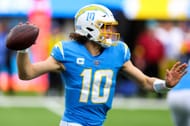
I rarely start with a quarterback ranked this highly and have been a subscriber to the idea of finding those late-round gems in fantasy drafts (such as Patrick Mahomes ahead of his 1st year as a starter, Lamar Jackson for his MVP season and others).
But as somebody who got burnt last year by the combination of Matt Stafford and Tom Brady falling in the double-digit rounds, I’m leaning towards addressing the QB position earlier in general. Then we need to acknowledge the fact that the difference between the elite guys in fantasy to the middle of the pack is as big as it’s ever been.
Herbert right now is one of the final two among the seven or eight guys you’d consider as part of that tier.
Just looking at the numbers, in three years with the LA Chargers, Herbert has finished ninth in total fantasy points (despite not playing Week 1) as a rookie, then second in 2021, and finally 11th this past season, when he cracked a rib all the way back in Week 2.
Even without any context about how the offense was constructed or how that injury lingered around and affected him throwing the ball, if he just has the 48.2 points he’s at least added as a runner in each of his first two seasons, he’s the number five QB in the NFL.
Adding context here, about not having his excellent young blindside protector in Rashawn Slater for 15.5 weeks, his top 2 WRs in Mike Williams and Keenan Allen missing 11 combined games and the fact he literally punted on a couple of plays just because the rib injury bothered him, and there would have to be a lot going wrong again for him to be in similar circumstances.
There’s been plenty of conversation out there about Joe Lombardi’s offense and what kind of insane levels they went to in terms of holding back Herbert’s ability to push the ball vertically. He was often led to check it down, due to not having the guys who could break open down the field, defenses being all over them, or just how plays were designed in the first place.
Herbert went from finishing second to only Matt Stafford with 25 passes of 40+ yards between 2020 and 2021 to just seven last year and he was 31st league-wide in intended air yards per attempt. That’s along with how static their concepts were and how few yards after the catch they gained because of it.
Now you have Kellen Moore coming in to call plays after four years in Dallas, where they finished between 4th and 9th in EPA per dropback in all but one of those (which is when Dak Prescott got hurt a month into the season) who has missed time otherwise too.
The way he marries the run-and-pass game is so much more impressive than what they did under Lombardi (where they lacked diversity in schemes they used in the ground game and defenses had a beat on when they did want to take shots off play-action from heavier personnel).
Mike Williams hopefully will be healthy for most of the season as one of the top ball-winners down the field. And then you’re looking at who they added in the draft.
First-rounder Quentin Johnston has to fix how he approaches the catch-point and take advantage of his size and hops when there is contact, but he has the burst off the ball to run by people and more importantly, he’s one of the scariest dudes when it comes to catching it on the move and what he can do with it at that size.
The only Power-Five receiver to average more than Johnston’s 8.9 YAC last season was actually his former TCU teammate Derius Davis (who the Chargers also selected in the 4th round and could be a gadget player for them) and Quentin has been a monster in training camp reportedly.
So a more well-designed offense, more firepower among the receiving corp (without putting pressure on Herbert to always make it happen) more dynamic passing concepts and healthy ribs.
All the signs are there for Justin Herbert to have his best season yet and you’re actually grabbing him on a value. To get him in the fifth round after you’ve already filled out your two RB and WR slots potentially is a path to take.
NFL fantasy diamond quarterbacks: Anthony Richardson
Average draft position: QB17, 128th overall
My rankings: QB12, 78th overall

This deservedly is the top-ranked rookie passer I believe. You’re not getting a huge bargain in the final couple of rounds (as your current QB17), but I think he can be that name among the guys you get somewhere into the double-digit rounds.
Anthony Richardson could deliver those huge weeks that end up putting you in the playoffs and ultimately winning you your league. Richardson only started 13 games at Florida, with all but one of those coming this past season (when he completed just under 54% of his passes for a little over 2,500 yards and 17 touchdowns vs. nine interceptions, along with 103 carries for 650 yards and nine more TDs).
So the raw numbers are certainly not up there with the two guys that went ahead of him in the actual draft, but he ended up sandwiched between those two in my real-life rankings. I think in terms of the hunt for one of the true superstars at the position, you could make a case for him being number one.
There were moments of defenses rotating the coverage or him not quite having calibrated what he can get away with, while mechanically there are things he can still clean up to perfect the way he gets the ball out. However, in terms of the quarterback-y things you may not be able to fix as quickly, such as keeping your eyes down the field, navigating the pocket and manipulating or using your eyes to lead conflict defenders the wrong way, there’s a lot to like already.
That’s along with the fact he has an absolute rocket attached to his right shoulder and literally is the freakiest athlete we’ve ever seen at the quarterback position, considering he beat several combine records.
That explosiveness doesn’t just show up when rushing for 70-yard touchdowns against LSU, but also the ability to create velocity on the ball and take advantage of smaller windows. His receivers didn’t help him out a whole lot even when he put the ball in spots for them where they could make a play on it, he was 10th in the FBS with a pressure-to-sack conversion rate of just 9.2%, had an insane 38% missed-tackle forced rate as a runner and only four of his 14 turnover-worthy play rates came over the final five weeks.
So while the real football and fantasy nerds may realize the potential and particularly in best ball formats, he probably comes off the board earlier than where he’s currently listed. In many of your home leagues people may think “I’m not taking this rookie, who’s inaccurate and a project altogether” – and that’s where you can capitalize.
I absolutely love his fit with the new Colts head coach Shane Steichen. Steichen helped Justin Herbert have a monster rookie season through a vertical passing attack with the Chargers. He also just helped Jalen Hurts be the runner-up for MVP with a much more simplistic approach offensively in Philadelphia. He took a lot OFF the quarterback’s mental plate and allowed the talent around him to shine while facilitating a rushing attack that enhanced Hurts’ strengths as a power runner.
Richardson may not be as cerebral as Herbert or as poised as Hurts at this point, but his talent altogether is superior to both of them I would say and he was asked to run an offense that lent itself more to the pro game than either of those guys, who both just received mega-contracts.
Indy has an interesting collection of skill-position guys, with their starters in 12 personnel all being between 6’4” and 6’7”, giving him maybe a little bit more room for error if he’s not pin-point accurate all the time, along with a couple of quick slot options to gain more separation.
I think under Steichen that entire unit could see a massive bump up and Richardson provides a steady rushing floor while having great upside. Especially if he’s presented with easier looks in the RPO game and is allowed to push the ball vertically to those tall targets, he could deliver plenty of big plays through the air as well.
After that group of seven or eight guys I referenced at the top, he could easily be right there as the next name up.
Honorable mentions: Geno Smith (QB14), Matthew Stafford (QB20) & Desmond Ridder (QB31)
NFL fantasy diamond running backs: David Montgomery
Average draft position: RB24, 66th overall
My rankings: RB16, 41st overall
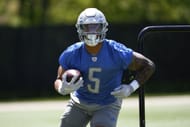
I wrote about Detroit's backfield back in the middle of June, when I listed them among the most-improved position groups across the NFL. At first glance, getting well over 2,500 yards and 27 touchdowns from that crew seems like they delivered appropriately. But I thought those numbers were more a reflection of the environment they provided those players and there was some meat left on the bone.
The Lions O-line (when mostly healthy) is tremendous and OC Ben Johnson is one of the most clever run-game designers in football, which is why nearly 62% of the rushing yards by that group came before contact. While Jamaal Williams did have by far his best season as a pro, at least his TD total was certainly inflated, as 13 of his 17 scores came from two yards away or less.
Looking at the underlying metrics, Monty has simply been a better player than Williams or D’Andre Swift, who the Lions happily traded away for a 2025 fourth-round pick from the Eagles.
If you take away his rookie season, he’s averaged 4.7 yards per touch despite being part of a Bears offense that never finished above 25th in DVOA in any of those three years there. Nearly 52% of his career rushing total has come after contact and he’s quietly gone over 1,000 receiving yards in four years.
This, as somebody who may not have the down-the-field ability that was so appealing with Swift coming out of college, but a consistent generator of positive plays on check-downs, who has only dropped nine of 163 career catchable targets.
What he has above those guys Detroit let move on this offseason is his ability to create individually, thanks to his contact balance and better change-of-direction ability than people give him credit for. His 138 missed tackles forced since 2020 rank sixth behind only Nick Chubb, Derrick Henry, Josh Jacobs, Dalvin Cook and Jonathan Taylor. This is very good company, especially considering all of them touched the ball more than Montgomery, playing for better offenses.
I get the concerns about Jahmyr Gibbs, who they drafted out of Alabama 12th overall after trading down. He’ll likely be a big part of the offense with his dynamic skills as a space player and underrated ability to make decisions between the tackles as a runner to contribute through multiple avenues.
However, looking at his final two seasons with Georgia Tech and Alabama respectively, he averaged just over 12 carries per game and only went over 20 twice across those. That’s along with Detroit constantly talking about him as an “offensive weapon” and the ways they could utilize him moved out of the backfield.
So we could see those two guys on the field together quite a bit. And with Gibbs right around 200 pounds, you’d think Monty doesn’t only have the clear path to passing downs snaps when they want to leave their back in protection but also as the primary goal-line option, looking at how they fed Williams down there last season.
While I loved Gibbs at Bama, I would prefer Monty straight up – and you can grab him 2.5 rounds later. I think setting his TD total at ten is fairly conservative, as depending on the format, you get some of those dump-offs on check releases when he’s on as a pass-protector. He’s the more proven rusher, who now gets to run behind the best offensive line of his career.
Even including his rookie season, he’s finished above the RB25 price tag he’s currently at all four years so far being part of one of the worst offenses in the league. Now as a top-six unit in DVOA and EPA per play last season specifically targeted him, paying him $6 million annually over Jamaal Williams who just finished as the RB8 in half-PPR is promising.
It just makes no sense to me, and considering the cost of the other guys in that unit, I’ll happily grab Monty in the sixth or seventh round to have a piece of this Lions attack.
NFL fantasy diamond running backs: Samaje Perine
Average draft position: RB39, 106th overall
My rankings: RB29, 81st overall
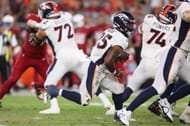
Samaje Perine was the clear RB2 in Cincinnati last year and is actually moving on to a worse offense if you go by 2022 numbers. But not only should his workload increase, but there’s plenty of reason to believe the arrow is pointing up for his new team.
Perine is quietly entering year seven as a pro and he has only started three games since his rookie season, but he’s been effective with the touches he’s received as a member of the Bengals. He is also coming off a year, where he put up 680 yards and 6 TDs on 133 opportunities.
I’d say he's not as sudden as Joe Mixon is for a bigger back and he doesn’t have great long speed, but he has a legit three-down skill set. Watching the two games he stepped in for Mixon last season, there wasn’t much of a drop-off. Against the Titans (the best run defense at that point) and the Chiefs (in a fairly high-scoring affair) he combined for 48 touches worth 248 yards.
For the full season, 71% of his total came either after contact or after the catch, so his production wasn’t necessarily tied to the offense he was in as much as people might think.
For Perine to be my recommendation may have some people scratching their heads. But as somebody who’s gotten bitten by trying to take advantage of the injury discount J.K. Dobbins has come with recently, I would rather be the one staying away from the guy with a multi-ligament injury in his knee.
Perine should have a substantial role either way and could end up bringing major surplus value. Especially considering Sean Payton called him as soon as free agency started and locked him up for the next two years at 8.5 million dollars, basically telling him he wants him to be the Alvin Kamara of this offense (after he had two backs touch the ball more than 150 times five straight times from 2016 onwards with the Saints).
Really, the Broncos can’t be much worse on that side of the ball than they were last year, whether that’s coaching, quarterback play, or injury luck. Of course, it’s not this simple, because Sean Payton had Drew Brees for almost his entire tenure with the Saints and quality throughout the offense. But just on the surface, only in the final two of his 15 years in New Orleans did his offense finish outside the top 10 in total yards and number one in six of those.
So the caché is certainly there, and while the QB situation is extremely volatile, with Russell Wilson coming off the worst season of his career by far, a lot of the other pieces are in place.
Payton immediately put his stamp on the organization with a couple of new starters on the O-line in Mike McGlinchey and Ben Powers. They are getting paid significant money, and both are better as run-blockers, so this gives them a really strong front-five.
They have assembled one of my favorite tight-end rooms across the league, where I can see them legitimately spend expended stretches in 13 personnel, and added a legit deep threat in Marvin Mims out of Oklahoma, who they traded up in the late second round for.
We don’t know exactly what run concepts they’ll lean into, although I’d expect a fairly varied approach, but even last season when it felt like a miracle if they were able to gain a first down through the air, they were at least average with 4.4 yards per rush.
While Javonte Wiliams is certainly capable of taking on a large portion of that workload if healthy, Perine was the third-down back for Cincinnati these last couple of years (seeing 51 targets this past season alone) and I’d think bringing him into the building, this is expected to be a significant part of his role in Denver as well.
Denver’s 319 vacated running back carries from 2022 are the second-most in the NFL and even though Javonte COULD take back the majority of those, I expect this to be much more in the 60-to-40% range.
So if Perine is just Latavius Murray from last year, who played 12 of 13 games in Denver, that would make him RB34, which is higher than where he’s going right now. If Javonte isn’t ready or – god forbid – gets hurt again, you may have a league-winner at your hands.
NFL fantasy diamond running backs: Jerome Ford
Average draft position: RB56, 161st overall
My rankings: RB44, 132nd overall
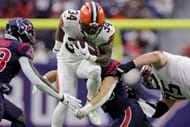
Obviously, if you can get Nick Chubb in the mid-to-late first round, that’s an investment I’d be happy to make, because he may be in a position to have his best season yet. With Kareem Hunt gone, we should see Chubb get a higher backfield share, extended goal-line work and potentially even more targets in the pass game.
With that being said, there is now room for a second player to emerge in place of Hunt and I believe Ford could be a much bigger contributor than people acknowledge. Especially considering the Browns also allowed D’Ernest Johnson to walk in free agency, Demetric Felton only received five opportunities over half the season he was active for in 2022 and the only RB they otherwise brought in was John Kelly (who has never been active for more than four games in as many seasons as a pro).
The sample size for Ford on offense is fairly limited, only handling eight carries for 12 yards and not seeing any targets in the passing game as a rookie. However, not only was that second to only Nick Chubb last season at the Browns, but he also handled kick return duties and finished sixth league-wide with an average of 24.1 yards per attempt.
So I wouldn’t say that the coaching staff didn’t trust him, but rather they had three backs already, who have proven they can produce with full-time workloads.
So what we have to do at this point is look at Ford’s track record in college. A former four-star recruit for Alabama originally, he decided to transfer to Cincinnati due to the loaded backfield he found himself in. It took until his senior year with the Wildcats to step into the starting role, due to having a first-team all-conference back there in front of him as well.
However, when he did finally get his opportunity to shine in 2021, he took full advantage, turning 236 touches into well over 1,500 yards and 20 touchdowns. I loved his no-nonsense type of running style, the ability to squeeze through tight creases, make those subtle adjustments to his path, the burst to get around the corner when defenses didn’t take care of contain responsibilities, the contact balance to bounce off arm-tackle or glance hits and the long speed to finish explosive runs in the end-zone.
The two metrics that really stood out about that senior year were 52 missed tackles forced on 215 carries and in what PFF calls “perfectly-blocked runs," nobody averaged more than his 11.2 yards per. Along with that, he was a much more reliable pass-catcher and pass-protector than the majority of college backs, averaging 10.5 yards per reception.
The Browns O-line has been one of the premiere units in football, in particular when it comes to the run game, for a while now. Over the last three years, they’ve never finished outside the top eight in either rushing yards or yards per rush. Head coach Kevin Stefanski comes from the Gary Kubiak school of outside zone, which is what they heavily concentrated on in Cleveland once he got there in 2020.
However, as he’s grown as a run-game designer and taken advantage of two All-Pro level guards with their blocking skills on the move, they’ve incorporated power and counter a lot more regularly. On top of that, with a longer and heavier center in Ethan Pocic being added to the mix this past offseason and promptly extended, we see them run at defenses a lot more now with inside zone or duo.
Chubb is clearly a master of navigating those tight spaces, processing defensive information and helping his line get the blocking set up. Yet, I believe there’s plenty to like about how Ford projects into that system as well. He may not be as refined conceptually, but his ability to exploit linebackers leveraging themselves the wrong way momentarily by exploding through the hole or slicing underneath a puller is very intriguing to me.
Then there’s the fact that Kareem Hunt was Cleveland’s primary option on third downs. I thought I saw a skill-set that projected very well for that type of role at Cincinnati with Ford and even if the Browns want to continue to increase Chubb’s carry total, I’d think it comes in hand with taking even fewer reps in designated passing situations.
So on top of getting a certain piece of the pie on early downs, he may be on the field for about 20% of offensive snaps via that avenue alone. As I envision how this offense may continue to evolve with Deshaun Watson having a full offseason with the team, I’d think spreading the formation and going back to him being one of the elite QBs out of empty sets in Houston, Ford will probably see more opportunities to catch the ball rather than being locked in protection.
So that alone is easily worth taking him ahead of ADP and if Chubb was to miss an extended stretch finally, you just hit the jackpot.
Honorable mentions: Dameon Pierce (RB22), Roschon Johnson (RB54) & Zach Evans (RB67)
NFL fantasy diamond wide receivers: Calvin Ridley
Average draft position: WR18, 42nd overall
My rankings: WR11, 26th overall
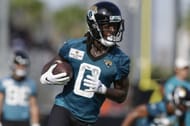
First and foremost, I just don’t believe people realize how freaking good Calvin Ridley was when last happy and part of a functioning NFL offense. I know it’s been a while, because he only played five games in 2021 before stepping away from football due to his mental health and then was suspended all of last season for violating the league’s gambling policy during his time off.
If you go back to 2020, he caught 90 passes for nearly 1,400 yards and 9 touchdowns across 15 games. With Julio Jones being in and out of the lineup that year, Ridley actually stepped up as the number one option and delivered in so many spots for a Falcons team that otherwise had very little going for it.
He finished as the WR4 in half-PPR that year and turned himself into one of the toughest covers, due to his pristine route-running. In fact, his 2.7 yards per route run ranked third league-wide – so it wasn’t just a product of getting a bunch of opportunities, yet he was able to make those count.
I was big on Christian Kirk last year because I saw the opportunity to be the top target in a much more well-coached offense and that we should follow the money. That worked out and so did taking Evan Engram at the end of drafts. That being said, Ridley is substantially better than both of those guys.
I think there’s a great balance between having the surrounding weapons to keep defenses from bracketing or just giving extra attention to Ridley, but at the same time, him being clearly the best of the bunch and able to get open regularly as the primary read.
Along with finishing last season 7th in total pass attempts, Trevor Lawrence had 55 completions of 20+ yards (third-most in the NFL) and he was tied for a league-low checkdown percentage at 3.4%. So there’ll be plenty of chances for his top weapon in the intermediate-to-deep range.
Doug Pederson and general manager Trent Baalke knew what they could get from this guy, which is why they traded a couple of draft picks last offseason, even though they would need to wait for a full year to take him off the shelf.
Ridley could make this offense even better, after they already finished top-10 in yards, points, DVOA and EPA per play. The areas Ridley could really take elevate them is in the red zone (as they only finished 20th in RZ touchdown range) and on third downs, as Trevor Lawrence was down at 23rd in conversion percentage on 3rd & medium (so three to seven yards short of the sticks).
Ridley may not look like what most people imagine in a great red-zone receiver, but his ability to win quickly and find room inside that condensed space helped him catch 26 TDs through his first three years. Unfortunately, there are no third down numbers for WRs available for 2020, but 74 of his 90 catches that year resulted in either a first down or a touchdown.
Just listening to him talk about how happy he is being back on an NFL field and his mentality going into 2023 has me very excited. Because I thought of him much higher than most people, understanding how pure a route-runner he is, being able to manipulate defenders one-on-one and his tremendous football IQ.
We’ve already seen some clips of him looking great during OTAs, he’s got a quarterback capable of delivering the ball to him at any spot on the field and all the arrows are pointing towards him potentially being a fantasy star this season.
I mean Zay Jones was a top-30 fantasy WR last year and Christian Kirk was top-15. Now Ridley is supposed to finish somewhere between those two names? No freaking way.
NFL fantasy diamond wide receivers: Jordan Addison
Average draft position: WR39, 87th overall
My rankings: WR27, 64th overall
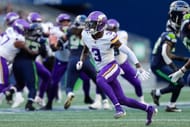
I had Addison as my WR3 in this most recent draft class, but I believe he has the clearest path to being very productive right off the bat, thanks to the situation he is in and how pro-ready he is entering the league.
While he’s not as fast or dynamic as some other guys in the class, I really liked the fact that after being the Biletnikoff winner for Pitt in 2021, catching passes from Kenny Pickett. With a lot of his production coming as a designated touch guy, he was able to make key plays more as a piece of the offense for USC and helped Caleb Williams actually win the Heisman trophy, rather than needing to be featured.
I get why the devy owners may not go crazy for a 175-pound receiver running right around 4.5 flat, but I believe after Bijan Robinson and the quarterbacks, he’s next up in terms of Offensive Rookie of the Year rankings and he’s right up there among my favorite number two receivers to target, in terms of a role for his team.
There’s a difference between looking fast on track and if you actually make defenders look slow on the field when you run routes against them. Addison doesn’t lose any time getting up to speed off the line and he routinely makes DBs overrun the break point.
His ability to make every route look the same during straight stems, then give them false information and create separation when he is actually ready to commit should translate fairly quickly. That’s how over his final two seasons and 25 games across them, Addison averaged just under 100 yards and just over one TD per game. He fixed his early drop issues, with just two all of last season, and while the contested catch rate took a significant hit last season, he was way above average in 2021.
At around 2.8 yards per route run each of the past two seasons in two different Power-5 conferences and as part of different offensive systems, I feel very good about his game translating to the pro level either way. Yet, if you consider the Vikings already have the best wide receiver in football in Justin Jefferson, I feel great about this guy being able to take advantage of those isolated situations when coverage is rolled toward the superstar (since his metrics were even better against man).
With 200 vacated targets available for the taking and no other WR additions outside of undrafted FAs, there’s plenty of opportunity to produce without cutting into the workload of Jefferson. Looking at Adam Thielen’s 2022 season (even with the worst marks of his career since 2016 with 6.7 yards per target, just a 22% contested catch rate and a measly 1.08 yards per route run), he still somehow ended up finishing as the WR31 in half-PPR. And the year before, he was a top-15 WR in points per game.
Minnesota saw a definite shift in play-calling philosophy under Kevin O’Connell, finishing third in pass-play rate at 64.4%, despite lacking a reliable number two up until they traded for tight-end T.J. Hockenson.
Addison is a definite upgrade over Thielen and anybody else on that roster, with K.J. Osborn as the only viable target outside of that. So if the rookie receiver just takes on the 107 targets Thielen left on the table and performs like an average number two, he easily beats that ADP.
If he’s any better, you might have a low-end WR2 in fantasy or at least a flex at your hands – and you’re getting him in the eighth or ninth round!
NFL fantasy diamond wide receivers: Nico Collins
Average draft position: WR53, 122nd overall
My rankings: WR38, 100th overall
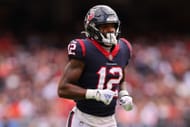
I think in Nico Collins we have somebody who casual NFL fans don’t actually know and don’t fully understand the role he will be in this season. New OC Bobby Slowik will be a first-time play-caller this season after DeMeco Ryans brought him along from San Francisco and having a rookie quarterback always comes with some questions.
However, just looking at Nico’s time in the NFL so far, 927 yards and three TDs across his first two years may not stand out a whole lot. But I’d think not a lot of people would know he averaged 48 yards per game last season, when he still had Brandin Cooks along with him in the lineup and was catching passes from Davis Mills.
Play-calling, quarterback play, target share and offensive success overall are pointing up and I could see Collins be in store for a pretty big season.
Going through the Next Gen Stats database, Collins was basically right in line with Davante Adams and Stefon Diggs (arguably the top two route-runners in the league) averaging 2.9 yards of separation and in terms of his 11.9-yard average depth of target. And with eight catches of 20+ yards in each of his first two seasons across 70 total, he’s been able to produce down the field quite a bit in relation to the opportunities he’s received.
Meanwhile, he also only dropped one pass in each of those years so far. This guy is 6’4”, 215 pounds with 4.43 speed, much better initial quickness off the line than you’d expect for his size. However, if he needs to release against the leverage of his defender, he can throw him the other way, has phenomenal body-control down the field to lean into and box out guys and what’s underrated about him is how efficient he is with instantly getting up the field once the catch is secured.
So understanding that he’s going to be the designated X receiver in Slowik’s offense, you have to love how well he projects for that. Not only has he been lined up there quite a bit already, but in Kyle Shanahan’s offense, that position is the primary read on the majority of dropbacks and is regularly set up with RAC opportunities.
Meanwhile, with QB C.J. Stroud coming in with the second overall pick, you feel pretty good about the fact that he ran quite a few West Coast staples already, even if fundamentally it was a more spread-out approach. But he also gives you much more in terms of dropping balls into the bucket down the field than most quarterbacks typically operating in those types of offenses may provide, to take advantage of Collins in more of a vertical sense.
On top of all that, the Texans have 99 more vacated targets than any other team in the league at a massive 357 total. And they do have several more options this season, signing FA Robert Woods, drafting Houston’s Tank Dell early in the third round and another top-50 pick from last year in John Metchie III thankfully getting back onto the football field, after beating leukemia.
So there may be a more fierce competition overall for targets, but none of those guys are suited for the role I expect Nico to assume.
The only guy in a similar mold on the roster is actually a sixth-rounder I like quite a bit in Xavier Hutchinson, but they already have a guy they invested a top-100 pick in and played 71% of offensive snaps when available in Collins. If he’s just part of your flex rotation, that’s a win based on ADP, and I think he could be somebody who delivers 8 to 12 points per week, to not make you upset on Monday (like some big-play receiver who didn’t get you that one long touchdown you were hoping for).
Honorable mentions: George Pickens (WR36), Terrace Marshall (WR89) & Khalil Shakir (WR92)
NFL fantasy diamond tight-ends: Kyle Pitts
Average draft position: TE5, 78th overall
My rankings: TE3, 39th overall
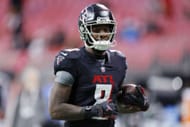
This is much less about just seeing a name way too low among its position group, rather than just believing in a player that most people are afraid of or just don’t want to invest in again. Fantasy managers got burnt by him last season, so the trust has been broken.
Kyle Pitts was the TE3 or 4, who you needed to target early, somewhere in the fourth round of your drafts a year ago. He repaid those people with just 28 catches for 356 yards and two touchdowns, before getting hurt 10 games into the season. And the majority of that production came in two games, with three or fewer catches and less than 30 yards in all but three of the ten contests.
So why the hell am I telling you to draft him this year? Well, just on the surface – this is just a 22-year-old unicorn at the position, who is 6’6”, just under 250 pounds, runs in the mid-4.4s, and has an 83.5-inch wingspan. And to me what’s most exciting is actually how well he can reduce that size and be crisp out of his breaks.
However, this is not just some uber-athletic project. He dominated the SEC in his final season with Florida and then became just the second tight end in NFL history to go over 1,000 receiving yards as a rookie. Pitts just only reached the end-zone once, to put him at TE7. Had he just gotten an average amount such as five, he would’ve already jumped up to number three at the position, behind only Mark Andrews and Travis Kelce that year.
I don’t believe that should be a major concern, because obviously if you have the length to reach over any defender, his body control and his hands, he has the tools to be a monster in the red zone. However, let’s for now look more at what he did as part of the every-down offense last season.,
To summarize my thoughts on why Pitts did as poorly last season, Atlanta was the only team to run it more than they threw it (at 51%). They were still developing their dropback pass game, while off play-action Pitts too often was sort of wasted as the threat in the flats. Most importantly, Marcus Mariota could not take advantage of this guy’s talent, in particular down the field, where he didn’t read leverage correctly and the ball placement was generally off.
I still believe they’ll run the offense a lot through the ground game, especially now with a special talent in eighth overall pick Bijan Robinson toting the rock, and Desmond Ridder is fairly unproven at this point.
However, I saw Arthur Smith open things up and create favorable passing looks for his young QB on early downs over the latter two of four starts. Ridder himself showed promising signs from within the structure and the way he would keep his eyes UP on the move, rather than Mariota quickly turning into a runner.
The opportunities are certainly a little more limited than they would be on a team with an elite QB, where they throw the ball on 60+ % of plays, but the narrative about the HC in Atlanta not wanting to use his dynamic weapon is just flat-out wrong.
Pitts was targeted on 28.5% of the routes he ran, and that number actually slightly went up when another top-10 draft pick at pass-catcher in Drake London was on the field at the same time. Yet, with his average depth of target going up by a full three yards to 13.8 per, the rate of uncatchable targets thrown his way went all the way up to 29%, the highest mark in the league among guys who ran 200+ routes.
Even with all of that in mind, there were some flashes of the tremendous talent that this guy is, where he’s elevating for back-shoulder fades that look indefensible if placed correctly, catching a slant over the middle with the safety looking to decapitate him, but the defender is actually the one staying down, or crossing up guys in the open field with the ball in his hands.
Really what it comes down to is you are drafting either a WR1 or 1A for an offense that may be more run-centric, but wants to hit big plays through the air, and has insane alignment versatility, to where it’s hard to bracket or just communicate accordingly how they will defend such a unique weapon.
If Arthur Smith is conscious about creating more favorable looks for his young signal-caller on first down and takes full advantage of the formational flexibility they present, I could absolutely see Pitts finishing behind only Travis Kelce among TEs. His opportunity is actually better than last year, but you can grab him a good three rounds later.
NFL fantasy diamond tight-ends: Greg Dulcich
Average draft position: TE12, 133rd overall
My rankings: TE10, 80th overall
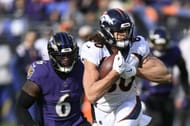
For anybody completely unfamiliar with the man spotting the most glorious mustache in the NFL, Dulcich was an early third-round pick for Denver last year, who started the year on IR. Across ten games played, he hauled in 33 of 55 targets for 411 yards and two touchdowns, for a top-ten mark at the position in yards per grab at 12.5 yards.
Being part of an offense that scored a league-low in points, he didn’t get much of a chance to stand out to people on a national scale, but anybody who’s watched this young man play understands that he offers a dynamic skill set for a tight-end.
Now with Sean Payton coming in and a full offseason to immerse himself into the offense, I believe we could easily see him double his rookie numbers and be much more impactful.
To put what the rookie did into context, the only other tight-ends, who were targeted at least double-digit times, with a higher average depth of target were Darren Waller and Kyle Pitts, despite how boxed-in this offense felt otherwise. And what makes this so impressive is this nugget, the only two TEs with double-digit yards of ADOT and at least three yards of separation on average were Mark Andrews and Dulcich.
His ability to stress defenses down the seams could change how coverages are structured against them, yet he also features a quick turn to take advantage of hook defenders dropping too deep. His speed can be used on a horizontal plane and he’s capable of shaking guys at the top of deeper routes, to where they sent him on a couple of corner-post routes last season, with the safety in two-high looks getting turned the wrong way by him.
The most important piece in producing fantasy value is being on the field, when available, their former coaching staff trusted him with playing 75% of offensive snaps at a position that is generally considered to be very difficult to adapt to coming out of college.
Dulcich has never been a great blocker, but he does bring good effort and his guy rarely makes the tackle. And while I don’t want to throw out lofty goals or a name that once was considered one of the premier offensive weapons in football, just understanding how Sean Payton utilized him and the fact that he surprisingly came out of retirement recently, there’s reason to believe Dulcich could be used in similar ways as Jimmy Graham.
He’s obviously not as big or imposing in contested situations, but he doesn’t mind high-pointing balls over the middle of the field and has the legitimate speed to create separation vertically when isolated.
Even last season when the passing attack faced several hiccups, they found ways to feature this guy and went to him quite a bit on third downs. Dulcich currently going at the fringe of being a TE1 in 12-team leagues, which I believe he absolutely is and he has the skill set to be among the upper half of that group (because Payton has highlighted a big slot receiver for the majority of his time in New Orleans).
So even if you think of Dulcich as more of a Marques Colston-esque player – even though the de-facto TE is actually faster – that’s a guy who went over 900 receiving yards and 5+ TDs in every year he played at least 12 games.
Honorable mentions: Sam LaPorta (TE23), Hayden Hurst (TE26) & Cade Otton (TE32)
NFL fantasy diamond defenses: Miami Dolphins
Average draft position: D/ST12, 216th overall
The Dolphins' defense fell off in a big way last season, in part due to missing a reliable number two corner and one of their starting safeties being hurt for half the year.
More importantly, the firing of Brian Flores as the head man under dubious circumstances, left DC, Josh Boyer, by himself and we saw opposing play-callers and quarterbacks dissect that scheme, which became very predictable. They couldn’t counter the answers offenses had found to punish their pressure packages.
After finishing 4th and 3rd respectively the prior two seasons in terms of fantasy points, they were tied for 18th league-wide.
This year, I believe they’ll be a lot more structurally sound under Vic Fangio, one of the main architects of the modern split-safety defenses, but not as easy to decipher as many of the off-springs we’ve seen (who just sit back in zone and allow opponents to pick them apart).
The ability to change the picture post-snap and force quarterbacks to hold onto the ball should allow this pass rush to get home more regularly, now that Bradley Chubb is there for a full offseason.
Jaelan Phillips turned himself into a game-wrecker over the latter parts of 2022 and Christian Wilkins will have opportunities to attack up the field much more regularly. You add David Long Jr. on the second level, who was a key component in Tennessee being the number one defense in success rate and EPA vs. the run last season, despite showing the second-lightest boxes across the league.
Jalen Ramsey over the collection of guys they were trying outside last year would’ve been a massive upgrade, and could have moved into the slot for certain downs and matchups. But now with him probably being out until late November, they did draft Cam Smith out of South Carolina in the second round, who has inside-out versatility himself, and that injury alone has given us a discount.
Miami has dropped two spots in positional rankings since I first collected the data. If they hit the way I think they could, you get Ramsey back for your playoff run in real life and fantasy.
I don’t think Vic ever had the full defensive talent for the Broncos available to him during his time as head coach there, but in his final season as DC in Chicago, they were the number one overall and fantasy defense in the league. So this Miami defense could absolutely be one that is a plus unit for 2023 rather than one that barely gets started in your leagues.
NFL fantasy diamond defenses: Cleveland Browns
Average draft position: D/ST16, 242nd overall)
Similarly to Miami, I believe Cleveland is judged way too much based on what they were in 2022 rather than looking at the depth chart and projecting what they could be this season.
They finished dead-last in rush EPA, outside the top-20 in takeaways and tied for 27th in sacks, despite having arguably the premier pass-rusher in football in Myles Garrett. And yet, they were tied for 18th with the Dolphins for fantasy purposes. So just based on that, all they’d need to do is improve by a couple of spots to live up to their ADP, but I believe they have room to rise a lot higher.
Everything that went wrong with that group last year had to do with the fact they could not win the line of scrimmage and consistently allowed opponents to stay ahead of the chains by running right at them.
They did not have a real nose tackle on the roster. That’s why they made Dalvin Tomlinson their big free agency addition and spent a draft pick just inside the top-100 on Baylor’s massive Siaki Ika to back him up (that’ll allow somebody like JOK, who led the NFL in run stop percentage last season, to run around freely and create negative plays).
Juan Thornhill replaces John Johnson at safety, who is much more of a play-maker to provide turnovers, along with having the range to play single-high when they want to man up with what might be the top trio of corners in the league. And then they addressed that edge position across from Myles Garrett through multiple avenues, signing Obo Okoronkwo as a true speed-ball around the corner, drafting Isaiah McGuire as more of a power-based player in the middle rounds, and then snatching up Za’Darius Smith once he became available.
Hopefully stopping the run at a higher rate will get them to more obvious passing situations, setting the table for their rush to get home and balls being thrown up for grabs.
Depending on the size of your league, this unit may not get drafted and if I end up in a situation where a receiver or back I’m still not sure about leading up to Week 1 is available, I may punt on defense initially and then just pick up these Browns the day of the season-opener.
NFL fantasy diamond defenses: Carolina Panthers
Average draft position: D/ST22, 276th overall)
Another one to pay attention to in deeper leagues. They’ve been a much better unit than the final rankings or general consensus would suggest. The offense has just been so bad that the dam broke at some point and NFL coaches started figuring out ways to defeat the scheme and pressure packages Phil Snow tried to apply.
The 17 takeaways and 35 sacks last season put them at 27th and tied for 25th across the league respectively, which are the two main ways to add points after you take off whatever, in accordance with how many points they allowed. However, even then, they were the number nine defense in fantasy, tied with what was perceived as one of the elite units in the Jets, for the entirety of last season.
Personnel-wise they’re bringing back pretty much every meaningful contributor, with emerging young players at all three levels, including Jaycee Horn looking like a shutdown-type of corner shockingly quickly after tearing his achilles early on as a rookie.
They also added Shy Tuttle from their division rivals in the Saints to firm up the interior D-line and added one of the most underrated safeties in the league in Vonn Bell, who was a super versatile piece in the Bengals’ success the last couple of years.
More importantly, they bring in one of the bright young defensive minds in the league in Ejiro Evero to run the show, who is much closer to the NFL meta in his general approach on the back end but is able to keep opposing teams guessing (with disguising coverage and giving the pass-rush more time to shine).
As the 22nd-ranked defense right now, I’m not advising you to actually waste your final draft pick on this selection, but if you’re desperate for a change at that spot or just need to fill it for a couple of weeks maybe, looking at Carolina facing Baker Mayfield/Kyle Trask twice this year and potentially three rookie quarterbacks in the AFC South, they are worth considering.
If you enjoyed this breakdown, please consider checking out the original video and feel free to check out all my other content here!
Twitter: @halilsfbtalk
Instagram: @halilsrealfootballtalk
Facebook: facebook.com/halilsrealfootballtalk
LA Chargers Nation! Check out the latest Chargers Schedule and dive into the Los Angeles Chargers Depth Chart for NFL Season 2024-25.
